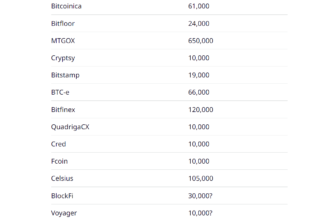
Crypto lenders are the institutions situated between consumers and the untamed, blockchain-based, and often unregulated space of cryptocurrencies. As such, they are in a peculiar position when it comes to responsibility towards their customers and the assets for which they provide services. Consequently, when choosing which currencies to support, lenders lead a delicate dance of responsibility, a balancing act between catering to popular demand and adding cryptocurrencies that are sustainable, worthwhile and safe.
Demand vs. approval: The question of endorsement
It’s unsurprising that in a nascent industry full of new investors, a lender’s asset integration is often taken for endorsement. What tends to be overlooked when companies add new assets to their range of services is that crypto lending is, in fact, a business, and any asset integration is ultimately a response to demand — a good market opportunity that generates gains for business and clients, alike. Perhaps this is due to lenders being influential entities in a space that has historically lacked the institutional stamp of approval and looks for it through the pioneering businesses shaping the industry.
In June 2021, Coinbase CEO Brian Armstrong issued a series of tweets concerning the exchange’s rapid integration of multiple assets and its intention to keep up this pace. Armstrong wrote that “one should not take being listed on Coinbase as an endorsement of that asset”, denoting the fine discrepancy between working with an asset and endorsing it. Even though their operations are different from that of an exchange, the same principle applies to crypto lenders: It is not an endorsement, it’s just business. And there are many ways to create client-centric and socially responsible businesses.
If not an endorsement, then what?
Listing an asset on a lending platform may not be an endorsement but it is an indication of a certain degree of its legitimacy, stability and security. A crypto lender’s operations with a given coin mean that owning it, investing with/in it and using financial services for it is regulatorily and technically sound. Lenders have a lot to lose from working with unreliable cryptocurrencies including funds as well as their customers’ trust and the future of their business; hence, they maintain high standards for an asset’s technical robustness, market-wide liquidity, price stability and legality. While the due diligence of these companies cannot serve as the aforementioned stamp of approval for investors, they can be a crypto wind indicator of sorts, providing a general indication of an asset’s stability and safety without endorsing it.
Crypto lenders have thus become the bellwether for regulatory action and it is worth noting that this intricate inter-dependence goes both ways — suspending services for cryptocurrencies immediately upon even the potential for new regulatory issues with a coin or token. This exact scenario played out on December 23, 2020, when multiple major exchanges and crypto lenders halted their XRP services in light of the U.S. Securities and Exchange Commission lawsuit of Ripple Labs. The valuable takeaway is that these institutions’ immediate reactions to even the possibility of legal issues with XRP demonstrate a tendency towards full compliance, competent legal counsel, and readiness for immediate action in accordance with given circumstances. Essentially, responsible crypto companies are the industry’s first reactors and can be useful to watch when navigating the space.
Related: SEC vs. Ripple: A predictable but undesirable development
Listings and the [Insert company name] effect
Although coin integrations on lending platforms do not denote endorsement, companies’ actions still have a strong collateral effect on cryptocurrencies. The biggest crypto exchanges in the world both have their respective so-called “Coinbase-effect” and “Binance-effect” that cause newly-listed coins to appreciate significantly in value. On one hand, this is because they suddenly become available to a wider audience of investors but in addition, their inclusion by these exchange giants gives buyers a sense of credibility.
A similar phenomenon was observed in 2020 when PayPal announced its plans to operate with Bitcoin (BTC): News spread quickly and had an overall uplifting effect on the market. This year, the predominant example was the “Tesla-” or “Elon-effect” which began with Tesla accepting Bitcoin as payment for its vehicles in March 2021 and then retracting this opportunity — needless to say, both actions caused a ripple in the crypto industry. A couple of months later, Elon Musk, himself, arguably triggered a market downturn that lasted nearly two months with a single tweet.
Related: Experts answer: How does Elon Musk affect crypto space?
These examples of non-crypto native companies’ influence on crypto prices are not even close to exhaustive and portray the sway big brands can have on the volatile crypto market. They signal a need for responsibility on part of all companies operating in the blockchain space, especially for crypto lenders who are set to become the banks of the new financial system. It is a volatile market with many smaller retail investors and new players. In the absence of regulation, the industry must self-regulate, recognizing and moderating the gravity of their listings, investments, statements and even tweets.
The technical side of listing assets
Generally speaking, there are two main approaches to adding new assets to crypto lending platforms. The first is a full blockchain integration and the second is a more internal-facing implementation. The former, enables users to deposit and withdraw assets from their wallets, giving them more overall flexibility. The trade-off is that such integrations take slightly longer, require scarce tech talent, and depend on finding appropriate and reliable third-party custodians to ensure the complete security of assets at all times.
The alternative to full integration is an approach akin to Revolut’s crypto offering wherein users may purchase cryptocurrencies and digital assets only on the lender’s platform, cannot withdraw them to an external wallet and therefore don’t have access to their private keys. Behind the scenes, the provider deals with the assets in their client’s name, producing user-friendly exposure to crypto investments that can be implemented on the crypto lender’s platform much faster than a standard integration. While Revolut has received criticism from the crypto community that prompted them to finally launch limited Bitcoin withdrawals in May 2021, this method has intrinsic value in a space as dynamic as blockchain finance and it’s why lenders like ours have taken on this adoption-friendly model for assets like Polkadot (DOT), Cardano (ADA), Dogecoin (DOGE), and the latest addition of Solana (SOL).
True to its struggle for ultimate security, the crypto community’s famous mantra of “not your key’s not your coins” was a natural hurdle for internal integrations. Regardless, they are flourishing on Nexo with $11, $28 and $12 million in turnovers from DOT, ADA and DOGE purchases, respectively, within the first month of launching these integrations. Despite not being able to self-custody their assets, clients use them extensively. People want and need exposure to the new assets popping up regularly in the rapidly growing space. Crypto lenders simply can’t keep up with this demand when using only the slower and exceedingly more resource-heavy blockchain integrations that give clients more control over assets, thus limiting exposure to many novel and well-performing coins.
“Not your keys, not your coins” embodies one of the essential benefits of crypto — the chance to take custody and security of your funds into your own hands rather than having to trust an institution. But perhaps the phrase is becoming slightly reductive as crypto begins to scale swiftly. For lenders and other companies using internal asset integrations, this strategy ought to be a springboard towards full integrations, a means through which to keep up with the industry, grow their business and give their clients timely exposure to lucrative investment opportunities.
The way forward: Social duties > Legal obligations
Ultimately, crypto lenders must mitigate the messages behind their asset listings, delicately weigh the words and actions behind their brands, and use different methods of integration to enhance their users’ experience in the dynamic industry. In an environment lacking regulations and common standards due to its nascence, a lot of these actions depend mainly on crypto companies’ social responsibility and blockchain-based corporate social responsibility (CSR).
This can include: 1) proactively shaping regulation for crypto as we have seen industry leaders do with regards to the pending U.S. Infrastructure Bill; 2) presenting audits of reserves as Nexo has done through its real-time attest via Armanino; or 3) educating customers — through articles, ask-me-anything sessions, support groups, even metaverse worlds — about the assets they work with, the services they offer, and how to use them safely and advantageously.
Developing, unclear regulation is something with which most industries have not dealt. Hence, the novel value behind crypto lenders and blockchain companies assuming more social responsibility and self-regulatory roles from the get-go is in the potential to create a more refined ecosystem with healthier relationships between clients, businesses and regulators. As crypto companies mature from start-ups to institutions with serious gravitas in blockchain and beyond, these principles of self-regulation and socially-minded services pave the way towards an ethically and morally guided financial world rather than one based solely on profit and legal obligations.
This article does not contain investment advice or recommendations. Every investment and trading move involves risk, and readers should conduct their own research when making a decision.
The views, thoughts and opinions expressed here are the author’s alone and do not necessarily reflect or represent the views and opinions of Cointelegraph.
Magdalena Hristova is a public relations manager at Nexo. With her penchant for writing and natural curiosity towards anything technically complex and equipped to cause ripples in incumbent industries, she began working as a copywriter in the crypto industry before migrating into the novel space of communications in crypto.










